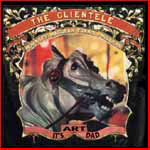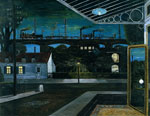
Being
a fan of the Clientele is
not like being a devotee of the Stone Roses or an admirer of Massive
Attack. You never have to wait
long for a new release in some shape or form, whether that’s a shared
7” or a short set of songs inspired by the paintings of de Chirico. Even so, it was hard not to start anticipating Strange
geometry from the moment of first hearing its title. And
even so, it’s an unexpected bonus to have a follow-up of sorts this
hot on its heels. A collection
of songs recorded for the most part between 1992-96, It’s
art dad is in some sense the equivalent of the Verlaines’ Juvenilia or Autechre’s Incunabula, though in fairness each of
those albums shows a more thoroughly evolved sound than the Clientele
were producing in their Hampshire loft.
I am a pushover for early
and lost or forgotten recordings now found and restored. I guess they appeal to the archivist in me,
or the completist. I confess I’ve
had dreams of turning up previously unknown albums by favourite groups
or extremely rare books by favourite authors. Georges
Perec wrote a perfect little story called ‘The winter journey’ which
in part reflects a similar phenomenon of yearning. In
it a young man reads a book picked from a friend’s shelves in a house
then destroyed in the war. A remarkable
work called The winter journey,
it appears to be the direct source and inspiration for some of France’s
greatest fin de sičcle poets and writers. So
begins a lifetime search for another copy of the book and proof that
its author actually existed. Perec
being Perec, it ends in a psychiatric hospital. I
consider myself duly warned.
When it - a record label’s
metal detector signalling material beneath the ground, and their bothering
to dig it up and dust it down - actually happens in what I assume are
my waking hours, it’s quite an occasion. Most recently it was impossible not to rush
out and buy Domino's Orange Juice and Fire Engines recordings. Equally eagerly sought were the pre-Postcard
recordings of the Go-Betweens on 78 ’til
79: the lost album, whose rough gems show that Robert and Grant might
have made a straighter pop album before the angular Send me a lullaby; the songs by the Hellfire Sermons which never
formed the basis of the two or three LPs they could have made, but which
finally appeared on Hymns: ancient
and modern; the treasure trove of the Scott Walker box set In five easy pieces; the Action’s astonishing Rolled gold LP-that-never-was, surpassing their frequently compiled
singles. The great twice-lost
Hurrah! demos. You might say the
whole of the Rev-ola and LTM catalogues respectively, but let’s mention
the Chuck and Mary Perrin recordings in particular. The
group you know and love may or may not have arrived at itself, but there
is enough of the search for a sound going on to render the ordinary recordings
interesting and the better ones exciting.
The four piece Clientele of It’s
art dad is instantly recognisable as a youthful version of the
current trio. The musical and lyrical preoccupations are
tentative forays in the sound and mood that would click into artful
place a year or two later; these are songs on the edge of turning into
those gathered together on Suburban
light. With its ‘English meadows’, ‘Elm grove window’ broad-brushes
the landscapes that would later be finely rendered. The rain is soft at the window in ‘The night
that changed our minds’. Musically ‘When
she’s tired of dancing’ has ‘I had to say this’ in its genes. ‘The evening in your eyes’ is the grandfather
of ‘Missing’ on The violet hour. It would seem that you can take the boy out
of Hampshire, but you can’t take Hampshire out of the boy, for compared
with their later evocation of London, the early recordings show that
Alasdair MacLean’s view of the world is stronger than the place he
lives. Or to turn it around, there’s not so much between
the lived experience of the country and that of the city. Each can in its own way give you a sense of
splendid isolation or night-time solipsism. Besides,
they were obviously making daytrips up to the Smoke, as ‘St Paul’s
beneath a sinking sky’ testifies.
Whichever Clientele pčre was
on the end of the flippant reply, ‘but it’s art dad’, I hope he now understands
that though it wasn’t quite realised, his son was well on the way to
being right. And I wonder - soon to embark on the reverse
journey of London to Hampshire - whether my daughter will ever say something
similar to me.

The
strange geometry that the Clientele want to portray is suggested by
the album’s cover art, ‘The viaduct’ by Belgian painter Paul Delvaux. The painting shows the junction of two desolate
streets at night, with a steam train running on raised track high above
them. The angular darkness is punctured by squares,
arches and globes of light. A
deviant, impossible mirror in the foreground, which might be a station
forecourt, renders the rest of the picture unreal. The
tone of the whole is mystery and absence. It
reminds me of a short story studied at school, the title and author
long forgotten, but possibly of the science fiction genre. It
portrayed little two-seater police bubble cars sending intersecting
triangles of yellow light from their headlamps as they pass. Otherwise, the only light seen by the character
walking in the street is the predominantly blue light emitted by television
screens from behind uncurtained windows in unlit houses. The character remains unsure as to whether
anyone is inside watching their images.
The
Clientele pick all manner of geometric forms from the quiet hum of
the studio and the chaotic hum of the cosmos, from the simplicity of
a triangle to the intricacy of an icosahedron. Tangents
touch and head away and acute angles open slowly from their points. Where previous recordings left in the smudges
and the fuzz, and let hesitant and delicate off-kilter songs veer further
from a straight path, here (to misquote Paul Klee) ‘the ear follows
the paths that have been laid down for it in the work’. This
is the sound of a trio totally in tune with itself, and this is the
album you always knew that the Clientele could bring into being, or
at least that someone could help them make. Produced
by Brian O’Shaughnessy with string arrangements by one time El recording
artiste, Louis Philippe, Strange
geometry is as free as Liberty
Belle and the Black Diamond Express and as bewitching as The
magical world of the Strands. For
all its bleak lyricism, it has a verdant, summery air compared to the
wintry frostiness of The violet
hour. ‘Since K got over me’ is perhaps the linking
piece, a ‘Jean’s not happening’ for the 21st century. Despite its conclusion that ‘I don’t think
I’ll be happy any more’, it’s almost an upbeat update on the song ‘The
violet hour’ (‘So that summer came and went and I became cold’). All the songs have that tempting, evasive quality
about them that makes you want to keep coming back to listen afresh,
to hear how all those ideas have settled down into a coherent whole. Instrumentally rich even without strings, you
still don’t know what’s round the corner of a new Clientele song. The production is subtly exquisite, exquisitely
subtle. Alasdair’s voice has
never sounded better, clean and clear and giving spirited flavour to
his lyrical themes: patterns which shift and break as quickly as they
formed, emptiness, worthlessness, silence, crowds, specifically summer
crowds, specifically summer crowds in Europe; a sudden glimpse within
them of a friend’s face which as suddenly vanishes. The
ghost of Ian Curtis is invoked on ‘Spirit’ as Alasdair reprises a phrase
from ‘Disorder’. There are echoes
of the shades of others in their themes and sounds just as there were
on first hearing them play live - the Dylanesque inflections in Alasdair’s
singing, most evident here on ‘Geometry of lawns’. And
as with Felt, or Yo La Tengo, there is the quietly unfolding sense
of vision and a gradual refining of sound across a panorama of recordings.
That
string arrangements can expose the ordinariness of a song and the obviousness
of a tune beneath or above them was never going to be an issue with
the Clientele. Their introduction
might have threatened the balance of their sound, but Louis Philippe
almost always walks the line between colour and restraint. You
sense that the songwriter did not originally have strings in mind when
they emerge within the revised version of ‘Impossible’, and here alone
they sit uneasily alongside the three-piece sound of the pop song. The other arrangements all work, adding an
extra layer of luminosity to ‘Step into the light’ without dominating
or sugar-coating the song, gliding like a plane through the air above
the earthbound character singing ‘E.M.P.T.Y.’, and coiling like the
ivy of the garden or the cemetery round the elegiac '(I Can't Seem
To) Make You Mine'.
© 2005 Daniel Williams